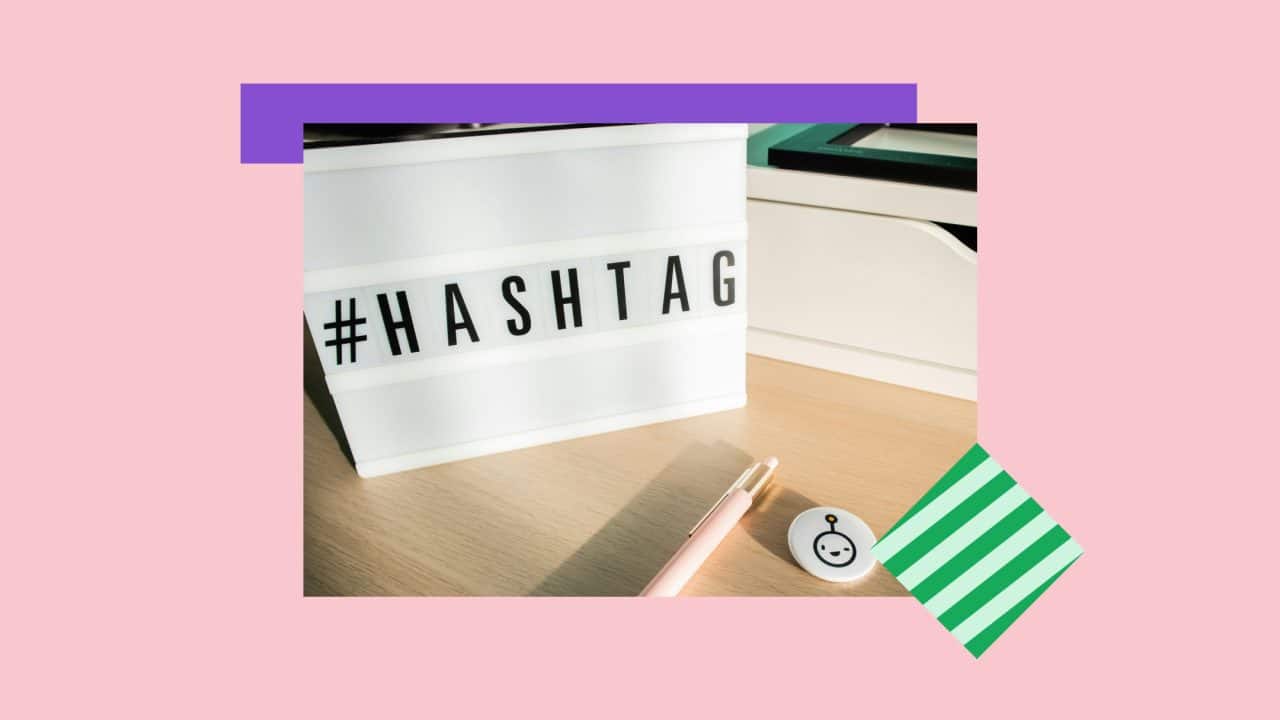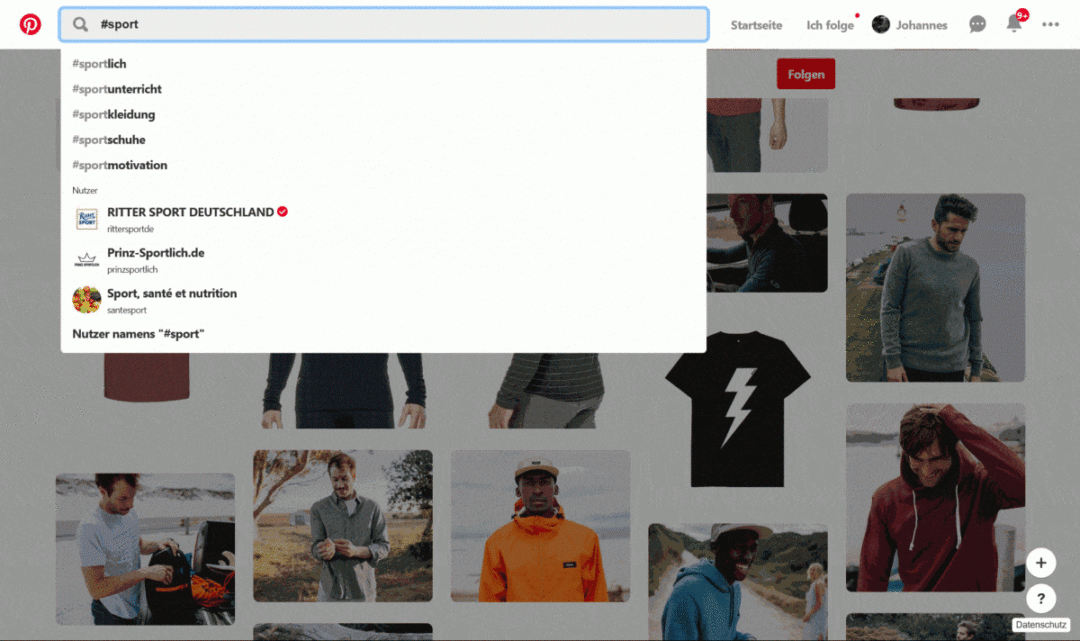
The Ultimate Hashtag Guide for Businesses 2025
Hashtags are inextricably linked to social media. At least that’s how it seemed until recently. Today, the following questions are cropping up more and more often:
- Should I still use hashtags?
- What do they help me achieve?
- How many hashtags are effective on which platform?
Here we take a closer look at the role that hashtags will play on various social networks in 2025 . We’ll also give you tips on how to find relevant hashtags and use them in a way that delivers on their promises.
Definition: What hashtags are
The term “hashtag” is made up of “hash” (English for “#”) and “tag” (English for “mark”). The character strings with hash marks were introduced on Twitter in 2007 following a suggestion by internet activist Chris Messina. Today, hashtags play a prominent role on Instagram alongside X. They can also be found on TikTok, LinkedIn, Pinterest and Facebook, YouTube, Bluesky and Threads. So they are practically everywhere in the social media world.
However, hashtags have one thing in common across all platforms: they serve as keywords that categorize posts thematically. Users can use hashtags to find posts on a specific topic or subject area and use hashtags for their own posts to ensure that they are found.
How hashtags work on various social networks
At first glance, all hashtags are the same. But the right hashtag strategy differs from platform to platform.
How hashtags work on Instagram
Instagram has become an integral part of marketing. The network now has two billion active users every month and has become the world’s third-largest social media platform.
The following applies to hashtags on Instagram:
- You can use up to 30 hashtags per post.
- Stories also allow hashtags. A maximum of 10 are available here.
Hashtags on Instagram can also be added retrospectively, i.e. after you have published your post. To do this, go to “Edit” and you can adjust the description and add hashtags later. This option is not available for Stories.
But are hashtags on Instagram 2025 reach boosters? CEO Adam Mosseri answers this question with a clear “no”, which doesn’t mean that they don’t still help others find your content.
How hashtags work on X
As the “birthplace” of hashtags, it’s hard to imagine the former Twitter without hashtags. Or is it? If Elon Musk has his way, yes:
Please stop using hashtags. The system doesn’t need them anymore and they look ugly. https://t.co/GKEp1v1wiB
— Elon Musk (@elonmusk) December 17, 2024
In fact, hashtags on X are appearing less and less frequently, and when they do, they are sporadic.
How hashtags work on LinkedIn
Hashtags on LinkedIn can help you to increase the reach of your posts. However, this effect is no longer as great in 2025 as it used to be.
You can put hashtags in the text or at the end. Basically, they work the same on LinkedIn as on Instagram or X. The important thing is not to overdo it and to remain professional or factual. Avoid creations like #picoftheday.
You are currently viewing a placeholder content from LinkedIn. To access the actual content, click the button below. Please note that doing so will share data with third-party providers.
More InformationHow hashtags work on TikTok
On TikTok, hashtags play an important role for TikTok SEO. You optimize your videos so that they are shown to your target group as often as possible in the For You Feed and in search. TikTok SEO works in a similar way to search engine optimization for Google. Here too, it is important to research suitable keywords and integrate primary keywords and secondary keywords into the text. Among other things, you should use your keyword base for your hashtags. The following video is a good example of what successful TikTok SEO looks like.
@1000thingsmagazine Ihr braucht beim Arbeiten mal einen Tapetenwechsel? Café-Office it is😉 #coffeeshop #cafeoffice #1000thingsinvienna ♬ Sure Thing (sped up) – Miguel
Important: Hashtags will remain an important part of a successful TikTok SEO strategy in 2025. However, other factors are becoming increasingly important for the classification of content. TikTok is increasingly relying on context analysis and is primarily using the video caption and subtitles as well as the spoken language in the clip. Interaction signals also play a key role in determining how many users see your content. You will achieve the best results if you combine hashtags with the right keywords in the text and relevant, interaction-promoting content, including popular sounds.
However, hashtags also play a role in community building. The hashtag #booktok, for example, brings young reading fans together. Hashtags are also central to the challenges that are so popular on TikTok.
@malika_bl Sind die viralen Bücher den Hype wert?📚 ➡️ Hab euch alle auf meiner Amazon Storefront (unter dem Link in meiner Bio) abgespeichert✨ #bücher #booktok #bücherempfehlung #buchtipps #colleenhoover #verity ♬ Cooking, bossa nova, adults, light(950693) – Kids Sound
Important: Trend awareness is a success factor on TikTok. But make sure that hashtags suit your brand and your target group.
How hashtags work on Facebook
Hashtags have been around on Facebook for some time now. And they have become established, at least in posts from companies. However, two or three suitable keywords are also sufficient here.
You are currently viewing a placeholder content from Facebook. To access the actual content, click the button below. Please note that doing so will share data with third-party providers.
More InformationHow hashtags work on Pinterest

Integrate relevant hashtags into the descriptions of your pins and ensure better findability. Note, however, that Pinterest displays the results chronologically when a user clicks on a hashtag. It therefore only makes limited sense to add hashtags to older descriptions. In addition, hashtags do not replace matching keywords.
Did you know that Pinterest is 33% more effective at driving users to your online store than Facebook? Used correctly, the image search engine is a goldmine for social media marketing. In our blog article “Pinterest Marketing 101: What you need to know for your business”, you can find out what you need to consider for a successful start to pinning.
How hashtags work on YouTube
Classic hashtags with hash marks have also been available on YouTube since 2021. All videos published for a hashtag can be found via a central hashtag landing page or the search function.
You can use hashtags in various places on YouTube. For example, you can use them in the title of the video to mark content series. If you include them in the description, they will also appear above the video title. As on other platforms, we recommend a small number of hashtags on YouTube. Three to four are ideal. If you add more than 15, YouTube will ignore all of them.
These are the benefits of the right hashtags in social media marketing
Before we look at the correct use of hashtags, the crucial question is: What advantages do hashtags still have today?
Or do we take a step back first?
There are several reasons why social media marketing managers use hashtags:
- Better visibility: Relevant hashtags are designed to make it easier for networks’ algorithms to categorize posts thematically and lead those users to your content who don’t follow you on the network in question. Ideally, these are members of your target group or at least people who are interested in your company and its services.
- More interaction: By increasing visibility in your own target group, hashtags should have a positive effect on the engagement rate.
- Higher brand awareness: Brand hashtags that contain the name of your company or brand, for example, can sustainably increase brand awareness. The same applies to successful campaign hashtags.
Hashtags also have cross-platform advantages, for example if you want to make events accessible to people on their computers or smartphones via social media walls or carry out cross-media campaigns. However, the same applies here as when using hashtags on Instagram or Twitter alone: only the right hashtags fulfil the expectations placed on them. Conversely, the “wrong” hashtags can even have a negative impact on visibility and interactions.
However, not only have times changed, but also the algorithms and search functions of social media platforms. Thanks to artificial intelligence, platforms such as Instagram no longer need hashtags to analyse and categorise content. They can also provide target groups with relevant content in this way. This also applies to videos for the most part.
This means that successful social media marketing will also work without hashtags in 2025. However, if you use them cleverly, you can still benefit from them and don’t have to reckon with disadvantages. Above all, you can still use hashtags to increase brand awareness and create lively communities.
Hashtags only fulfil their purpose in conjunction with the right content. You can find out how to plan, create and publish this in our e-book “The art of social media content creation”. Download it now for free.
Tips for using hashtags
Wild hashtagging is not a good idea. Instead, follow these tips for using hashtags.
The right number of hashtags
How many is enough? The answer to this question depends on the platform.
A few examples:
- On X, frugality is a virtue. One or two hashtags are usually enough, but if Elon Musk has his way, even that is too many.
- For Instagram, Adam Mosseri recommends no more than 5 hashtags. This is significantly fewer than used to be the norm.
- 3 to 5 is considered a good number for YouTube, LinkedIn and TikTok.
It is important not to slavishly follow fixed values. Despite all recommendations, there are cases in which companies are more successful with 6 or 7 hashtags per post than with 5. The only way to find out which is your “lucky number” is to try it out. Generally speaking, because hashtags are no longer as important for visibility as they used to be, fewer are usually better than more.
Avoid irrelevant hashtags
If the content and hashtag don’t match, it can quickly backfire. Users then feel annoyed and quickly click on “Do not show for this hashtag”. If this happens too often, your content may no longer be displayed under the relevant hashtag.
What’s more, you don’t want to attract just anyone to your profile, but people who belong to your target group, and above all real people, not bots. However, you can only achieve this if you use hashtags that are relevant to your target group.
Popular hashtags and niche terms – why you should use both
There are basically two tactics when choosing hashtags:
- Popular terms: By using hashtags that are particularly popular in a network, you increase your chances of reaching many users. However, this also increases the risk of your posts getting lost in the crowd. This risk is particularly high for unspecific hashtags with many millions of posts, such as #follow4follow. The same applies to the risk of appearing dubious. Because let’s be honest: begging for followers doesn’t look very confident. Popular hashtags on Instagram that are worth recommending include #photooftheday, #selfie or #contest, provided they fit the content.
- Specific hashtags: Specific hashtags naturally limit the selection of users who see them. But this is often an advantage. Because the people who respond to specific hashtags are more likely to be future customers.
Which tactic is better? Ideally, you should combine both. This means that you use both popular hashtags to reach many people and specific ones to target your audience. However, stay away from hashtags that are “too popular” and regularly inform yourself about censored hashtags on Instagram. The platform often blocks harmless terms such as #brain, #easter or #publicrelations for a certain period of time because they have been reported as inappropriate by the community.
Use brand hashtags
A special form of hashtags are the so-called “brand hashtags” or “branded hashtags ”. Ideally, they promote the brand image decisively. There are several variants of such brand hashtags:
- Variations of company and brand names
- Claims
- Slogans
- Campaign hashtags
An example of a successful brand hashtag is Nike’s #justdoit. By contrast, Coca Cola’s #shareacoke is one of the outstanding campaign hashtags. It is important to choose hashtags with recognition value and to avoid duplication or possible confusion. Sometimes, as in the case of Kaufland, #companyname also works.
Be short and concise and avoid misunderstandings
Brevity is the spice of life, but above all the recognition value. And this is crucial for successful hashtags. Therefore, avoid long and cumbersome strings of words, even if the result seems very creative and funny to you. Also pay attention to whether possible misunderstandings can arise if several words are written together. There are several examples of embarrassing ambiguities. Use CamelCase to make several words easier to read: #ThisIsEasierToRead
Pay attention to correct spelling
It’s actually a matter of course, but it’ s easy to lose a letter when setting hashtags. Then it no longer fulfils its purpose. You should also avoid hashtags that only consist of capital letters. This quickly comes across as aggressive. Emojis, on the other hand, can provide variety and eye-catchers in social media.
How to find good hashtags
There are several ways to find good hashtags for social media:
Use AI tools
Tools such as ChatGPT, Hashtagify or RiteTag help you to identify suitable and performant hashtags. You can also use the free hashtag generator from Sistrix. Swat.io also offers you the option of having the AI deliver suitable hashtags directly when creating posts.
Speaking of Swat.io: Are you already familiar with our comprehensive social media tool? Find out about our features now, start a free trial and save a lot of valuable time!
Use platform search
You can search for suitable hashtags on many platforms using the search function. All you have to do is enter a hashtag. You will then be shown popular relatives.
Follow hashtag trends
To stay up to date, you should regularly check hashtag trends:
Good sources for current trends:
- X Trends (often first-mover for new hashtags)
- Instagram Explore Page
- TikTok Discover Page
- Google Trends (search for hashtag trends in your niche)

Align with influencers and competitors
Look at which hashtags others are using successfully. It is important that the person or company appeals to the same or a similar target group as yours.
Hashtags are not dead yet
Sie sehen gerade einen Platzhalterinhalt von Standard. Um auf den eigentlichen Inhalt zuzugreifen, klicken Sie auf den Button unten. Bitte beachten Sie, dass dabei Daten an Drittanbieter weitergegeben werden.
Weitere InformationenOkay, they may smell a bit strange. And the fact is: in 2025, you can be successful on social media without any hashtags at all, whether on Instagram, TikTok or LinkedIn.
But with a sparing, targeted use of keywords, you can still draw attention to yourself and your offering and boost interaction. The prerequisite is that you choose hashtags carefully and use them sparingly. For all platforms, we advise against inflationary use. This tends to have a negative effect on reach and interaction.
Perhaps even more important: in 2025, good content is more important than ever on social media. If your content strikes a chord with your target group, hashtags are just a small, subtle addition to your social media strategy.
With the right tool, your Social Media Marketing is even more efficient. Swat.io helps you with planning and publishing content, in customer care, and much more! You can also find out how your hashtag is performing. Start a free trial now and take your Social Media Marketing to the next level.
 24. April 2025
24. April 2025 








